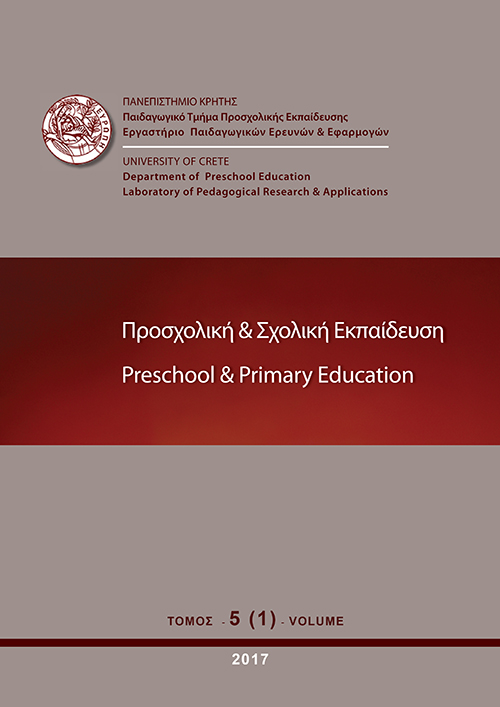Η σχέση μεταξύ των γλωσσικών και των ψυχοκοινωνικών δεξιοτήτων των μαθητών: Εκπαιδευτικές προεκτάσεις

Περίληψη
Οι δεξιότητες γραμματισμού και η ψυχοκοινωνική προσαρμογή τελούν κρίσιμους παράγοντες της σχολικής επιτυχίας. Οι περισσότερες σχετικές έρευνες έχουν επικεντρωθεί κυρίως στη σχέση ανάμεσα στις αναγνωστικές δεξιότητες και τα προβλήματα συμπεριφοράς, χωρίς να ασχολούνται και με άλλες παραμέτρους του γραμματισμού, όπως τις δεξιότητες παραγωγής γραπτού λόγου καθώς και περαιτέρω πτυχές της ψυχοκοινωνικής προσαρμογής όπως την ακαδημαϊκή, την κοινωνική και τη συναισθηματική προσαρμογή. Στόχος της συγκεκριμένης μελέτης ήταν η διερεύνηση της σχέσης ανάμεσα στον γραμματισμό (αναγνωστικές δεξιότητες, παραγωγή γραπτού λόγου) και την ψυχοκοινωνική προσαρμογή (κοινωνική, συναισθηματική, ακαδημαϊκή επάρκεια και προβλήματα συμπεριφοράς) σε μαθητές Δημοτικού σχολείου τυπικής ανάπτυξης. Στην έρευνα συμμετείχαν 73 μαθητές/τριες από την 5η και 6η τάξη του Δημοτικού σχολείου. Τα παιδιά αξιολογήθηκαν ατομικά σε σταθμισμένες δοκιμασίες που εξέταζαν τον γραμματισμό και την ψυχοκοινωνική προσαρμογή. Τα αποτελέσματα έδειξαν ότι οι αναγνωστικές δεξιότητες σχετίζονταν θετικά με την κοινωνική και σχολική προσαρμογή και αρνητικά με τα προβλήματα συμπεριφοράς. Ακόμα, προέκυψε ότι οι δοκιμασίες της παραγωγής του γραπτού λόγου ήταν στατιστικώς σημαντικοί προβλεπτικοί δείκτες για την συναισθηματική προσαρμογή. Στη συζήτηση παρατίθενται τα συμπεράσματα της έρευνας και αναδεικνύονται οι εκπαιδευτικές τους προεκτάσεις.
Λεπτομέρειες άρθρου
- Πώς να δημιουργήσετε Αναφορές
-
Ralli, A., Karagiannopoulou, D., & Antaraki, I. (2017). Η σχέση μεταξύ των γλωσσικών και των ψυχοκοινωνικών δεξιοτήτων των μαθητών: Εκπαιδευτικές προεκτάσεις. Preschool and Primary Education, 5(1), 84–96. https://doi.org/10.12681/ppej.10756
- Τεύχος
- Τόμ. 5 Αρ. 1 (2017)
- Ενότητα
- Άρθρα

Αυτή η εργασία είναι αδειοδοτημένη υπό το CC Αναφορά Δημιουργού – Μη Εμπορική Χρήση – Παρόμοια Διανομή 4.0.
Οι συγγραφείς των άρθρων που δημοσιεύονται στο ΠΡΟΣΧΟΛΙΚΗ & ΣΧΟΛΙΚΗ ΕΚΠΑΙΔΕΥΣΗ διατηρούν τα δικαιώματα πνευματικής ιδιοκτησίας επί των άρθρων τους, δίνοντας στο περιοδικό το δικαίωμα της πρώτης δημοσίευσης. Άρθρα που δημοσιεύονται στο ΠΡΟΣΧΟΛΙΚΗ & ΣΧΟΛΙΚΗ ΕΚΠΑΙΔΕΥΣΗ διατίθενται με άδεια Creative Commons 3.0 και σύμφωνα με την άδεια μπορούν να χρησιμοποιούνται ελεύθερα, με αναφορά στο/στη συγγραφέα και στην πρώτη δημοσίευση για μη κερδοσκοπικούς σκοπούς και με δικαίωμα τροποποίησης μόνον με παρόμοια διανομή (αν αναμείξετε, τροποποιήσετε, ή δημιουργήσετε πάνω στο υλικό, πρέπει να διανείμετε τις δικές σας συνεισφορές υπό την ίδια άδεια όπως και το πρωτότυπο). To Εργαστήριο Παιδαγωγικών Ερευνών και Εφαρμογών του Παιδαγωγικού Τμήματος Προσχολικής Εκπαίδευσης του Πανεπιστημίου Κρήτης και το Εθνικό Κέντρο Τεκμηρίωσης διατηρούν το δικαίωμα να δημοσιεύουν, να αναπαραγάγουν, να παρουσιάζουν στο κοινό, να διανέμουν και χρησιμοποιούν άρθρα που δημοσιεύονται στο ΠΡΟΣΧΟΛΙΚΗ & ΣΧΟΛΙΚΗ ΕΚΠΑΙΔΕΥΣΗ σε οποιοδήποτε μέσο και μορφή είτε μεμονωμένα είτε ως μέρη συλλογικών έργων, για όλο το χρόνο διάρκειας προστασίας της πνευματικής ιδιοκτησίας και για όλες τις χώρες του κόσμου. Αυτό περιλαμβάνει ενδεικτικά και όχι αποκλειστικά, το δικαίωμα δημοσίευσης των άρθρων σε τεύχη του περιοδικού ΠΡΟΣΧΟΛΙΚΗ & ΣΧΟΛΙΚΗ ΕΚΠΑΙΔΕΥΣΗ, αναπαραγωγής και διανομής μεμονωμένων αντιγράφων των άρθρων, αναπαραγωγής ολόκληρων των άρθρων σε άλλη έκδοση του Εργαστηρίου Παιδαγωγικών Ερευνών και Εφαρμογών του Παιδαγωγικού Τμήματος Προσχολικής Εκπαίδευσης του Πανεπιστημίου Κρήτης και του Εθνικού Κέντρου Τεκμηρίωσης και αναπαραγωγής και διανομής των άρθρων ή περίληψης αυτών με χρήση πληροφορικού συστήματος αποθετηρίου.


